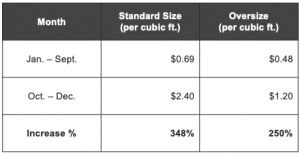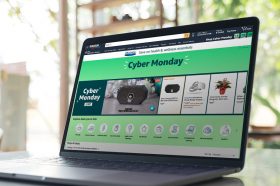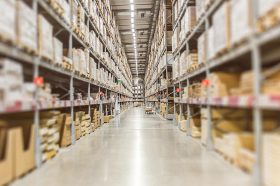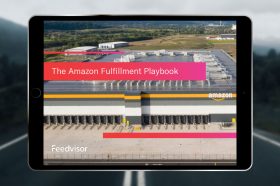Resources - Blog
How to Maximize Sales Through Amazon FBA [Webinar Recap]
![How to Maximize Sales Through Amazon FBA [Webinar Recap]](https://feedvisor.com/wp-content/uploads/2019/12/Maximize-sales-through-amazon-fba-2.jpg)
Stay on top of the latest e-commerce and marketplace trends.
In 2019, 50% of Amazon sellers utilize FBA as their primary fulfillment method.
Undoubtedly, there are numerous advantages to implementing Fulfillment by Amazon (FBA) into your marketplace strategy. To start, your products become part of one of the most advanced fulfillment networks in the world. In 2019, Amazon operates over 175 fulfillment centers globally and the company is constantly integrating cutting-edge technology and robotics to optimize efficiency.
Other benefits of FBA include Prime eligibility, which enables you to reach Amazon’s most lucrative customer base; flexible fulfillment orders with no minimum requirement, which can be particularly helpful during busy times of the year; and Amazon handles customer service and returns for FBA orders, which eliminates the need to hire and train people to work for you and grants you more time to focus on scaling your business.
In addition, having the Amazon brand attached to your products exudes trust and credibility to consumers. Shoppers know they can expect excellent customer service and rapid delivery and, as a result, FBA can lead to increased Buy Box share and conversions.
With so many benefits, it is no surprise that the program is so popular among all types of businesses operating on Amazon’s marketplace. However, if you utilize FBA, you know it also comes with its own set of challenges — particularly the fees associated with the program — which can have serious consequences to your bottom line.
In this webinar, How to Maximize Sales Through Amazon FBA, Abhimanyu Saraf, strategy and process advisor for Amazon Marketplaces at Rekonnekt Commerce, breaks down the intricacies of Amazon’s FBA program as well as how to leverage its loopholes to reduce costs, maximize sales, and increase profitability.
Inventory Planning and FBA Storage Fees
Inventory management is crucial to the success of any e-commerce business. However, when it comes to Amazon FBA, you must be particularly strategic about the amount of inventory you send to Amazon, given the high cost of FBA storage fees, which are outlined below.

FBA storage fees can be up to 3.5x higher in Q4 than earlier periods of the year and, if you are not cautious about the inventory you send to FBA, your storage costs could kill your profit margins. To avoid this, Abhimanyu suggests the following:
- Send your inventory in small, frequent bullets to FBA fulfillment centers once per week rather than sending large batches once or twice per month.
- In September, remove and liquidate all of your excess or slow-moving inventory to avoid racking up storage fees on dead or nearly dead stock as you head into the holiday season.
- Calculate additional days into your delivery timeline during Q4. Particularly after Thanksgiving, inventory can take up to three or four days longer for Amazon to receive due to the large influx for the holiday season. Be prepared for this to avoid losing out on sales during this time.
In addition, Abhimanyu advises sellers to be cautious of long-term storage fees (LTSF), which are charged for inventory that has been in storage for more than 356 days and can be up to 14x the cost of normal storage fees. In this case, you could end up paying an entire year’s worth of storage fees at one time.
To avoid this, check your Inventory Age report in Seller Central under the column that shows stocks aged between 180 days and 270 days. Take note of all the stocks in that date range and start liquidating your inventory by reducing prices by up to 20%. Abhimanyu suggests spending anywhere between 30% to 40% more on your cost-per-click (CPC) advertising campaigns and, if there is still some wiggle room, give an additional 5% or 10% discount to rapidly liquidate the inventory and increase your sales.
Lost and Damaged FBA Inventory
One inevitable factor of doing business via Amazon FBA, which all sellers experience at one point or another, is having inventory lost or damaged in the fulfillment process. Oftentimes, the error is on Amazon’s end, not the seller’s.
In these cases, Amazon will reimburse the sellers proactively. However, some cases might go unnoticed — by both Amazon and the seller — during which the inventory is damaged and your money is lost. To prevent this, you must thoroughly monitor your Seller Central reports and raise claims with Amazon when you catch any discrepancies.
The two reports you should continuously monitor are the Inventory Adjustment report and the Reimbursement report. If you catch an issue with misplaced inventory that has not been recovered, Abhimanyu urges you to file a case with Amazon and wait 45 days from the date of the event to check your Reimbursement report. By then, the report should reflect Amazon’s reimbursement for your misplaced inventory.
Another common occurrence with FBA is short shipment receiving, in which Amazon has short received inventory that you send to the FBA warehouse. For this, you must compare your records of what you shipped versus what Amazon says it has received. If there is no gap on your end, then you must raise the issue with Amazon to get reimbursed for the missing inventory. You must have a minimum of 45 days before you can file a case, and a maximum of 180 days.
While it can certainly be tedious and time-consuming to continuously monitor your inventory reports and file claims with Amazon, Abhimanyu notes that regularly checking and filing cases for damaged, lost, and short inventory can add up to 5% to your bottom line.
Maximizing the Value of Your FBA Strategy
Certainly, Amazon’s FBA program helps sellers increase their sales, but there are few other hidden, lesser-known fees that can eat into your profits. Be cautious of the following and plan your inventory accordingly to avoid potential profit loss.
- Removal Fees – All of the defective, damaged, and unsellable stocks in FBA need to be recalled. There is a removal fee charged in all cases. Automate removals to frequently get back stocks, sort them, and add back some stocks that are sellable.
- Preparation Charges – This includes labelling, poly-bagging, taping, and others. Many products need special handling before they are made available for sale. Amazon charges a per-unit fee and sometimes takes up to a week to prepare products before they are available for sale.
- Disposal Fees – Even if you want to dispose your unsellable inventory, there is a charge.
- Negative Feedback Removal – Most of the negative feedback for FBA orders can be removed. This can be a major booster in getting more Buy Box share.
Lastly, to maximize the value of your FBA strategy, Abhimanyu shared some tips for leveraging the program’s loopholes. While Amazon has over the years plugged most of its FBA loopholes, optimizing the program to be more like a technology product, there are still some areas of opportunity that your business can take advantage of, including:
- Heavy Items – Items that weigh more than 20 pounds are more expensive to fulfill through FBA. The higher the weight, the more expensive it is through FBA. With this in mind, you should keep your FBA items small, light, and of high value.
- Fulfillment Fees – Sometimes the fulfillment fee per item changes without any warning or intimation on Amazon and, suddenly, all your profits vanish. Keep a regular tab on the fulfillment fees and calculate exactly how much you should be paying and compare against your costs.
- Small and Light Package – When planning to FBA a private label product, design the packing in a way that yields the smallest FBA fee and qualifies for a standard package, rather than an oversized package.
- Direct From Supplier to FBA – Send shipments directly from the supplier into FBA, share all details and documents with the supplier, pay a slightly higher fee, and get goods into FBA directly. This will save you time, manual effort, and shipping costs.
Learn what Feedvisor can do for your business.
When you partner with Feedvisor, you automatically receive access to our true, AI-driven technology and hands-on team of e-commerce experts. Contact one of our team members today to learn more about our end-to-end solution for brands and large sellers on Amazon, Walmart, and e-marketplaces.




